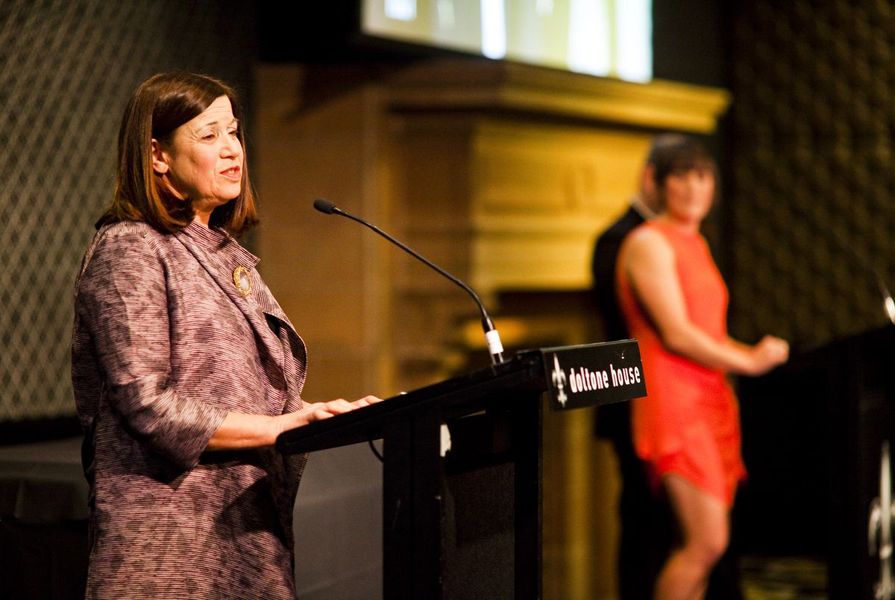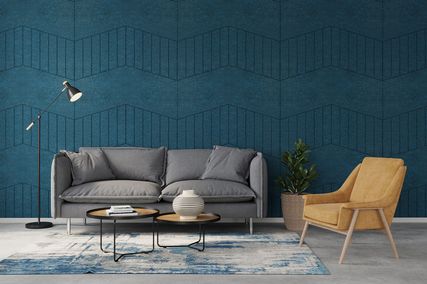When the 2003 Gold Medal was awarded to Melbourne architect Peter Corrigan in honour of three decades of work, the citation opened with a note from Corrigan acknowledging the enormous contribution to the work by his partner in life and practice, Maggie Edmond.
Twenty years later, the Institute asked the 2023 Gold Medal Jury to consider whether there had been an oversight in acknowledging only one member of the duo whose longstanding collaboration was responsible for the practice of Edmond and Corrigan. The jury was undivided in its conclusion that the work celebrated in the 2003 Gold Medal was that of the partnership.
It is with great pleasure that the 2003 Gold Medal is awarded to Maggie Edmond and Peter Corrigan for a collaboration that presented some of the most innovative and inspiring voices to the Australian architectural scene. Here, Philip Goad pays tribute to Edmond.
— Shannon Battisson on behalf of the 2023 Gold Medal Jury
In the history of Australian architecture, there have been many partnerships of note, some of them personal as well as professional. One thinks, for example, of Marion Mahony and Walter Burley Griffin, and of Malcolm Moir and Heather Sutherland in Canberra; of John and Phyllis Murphy, and of Peter and Dione McIntyre in Melbourne; of Bill and Ruth Lucas in Sydney; and of many others past, present and still to be documented. In 1975, one of these partnerships of “significant others” was formed by Maggie Edmond and Peter Corrigan.1 It was a partnership that would, over the next three decades, shift architectural thinking locally, nationally and even internationally – sometimes controversially.
It was Edmond and Corrigan’s series of buildings for the Catholic community at Keysborough in outer-suburban Melbourne that first made architectural headlines nationally.2 Their new church, parish centre, childcare centre and school used the everyday language, forms and materials of the suburbs, signalling an alternative to traditional notions of Catholic worship and educational buildings. The Keysborough Church of the Resurrection (1977) was the first building to be completed. It was a larrikin cry from the suburbs and a pivotal moment in the contemporary debate between the prevalent regional modernism and an emerging postmodernism.
Edmond and Corrigan’s Keysborough Church of the Resurrection (1977) marks a pivotal moment in the history of Australian architecture.
Image: John Gollings
Over the following decades, Edmond and Corrigan went on to win numerous high-profile awards, including 35 state and four national awards in the Royal Australian Institute of Architects’ awards program, as well as three Victorian Architecture Medals. In 1982, the practice received the National ACI Architecture Award “for the most outstanding contribution to the development of architectural theory expressed in completed buildings having particular relevance and significance to the Australian regional context.”3 The firm’s work was exhibited internationally in 1982 at the Paris Architecture Biennale and in 1991, 1999, 2002 and 2010 at the Venice Architecture Biennale.
Edmond and Corrigan had individual and very different architectural experiences before they joined forces. While Corrigan’s career trajectory is well known through his studies at Yale and experience working in the United States for figures including Kevin Roche and Paul Rudolph, Edmond’s is distinguished by her early connections to community-building, activism and recognition of the intrinsic value of the historic Australian city. (These qualities would emerge in the practice’s work after 1975.) Winsome Callister’s compilation of the pair’s design works before 1975 indicates that Edmond was involved in more than twice as many design commi-ssions as Corrigan.4
Born Margaret Suchestow, the daughter of a Viennese father and an Australian mother, Maggie Edmond studied architecture at the University of Melbourne, graduating in 1969. She was a brilliant, prize-winning student, known for her outstanding renderings. Her design thesis was for a high school and community centre and, as Conrad Hamann has noted, “its urban sense was very strong.”5 In contrast to Corrigan’s connections to actors and set designs associated with the Australian Performing Group (APG) based at the Pram Factory theatre in Carlton, Edmond worked with other local theatre groups, mainly through the Melbourne Secondary Teachers’ College, designing costumes for the Gilbert and Sullivan Society productions. She worked briefly in Sydney on the giant polygonal Hyatt Kingsgate Hotel in Kings Cross, then in Melbourne for Meldrum Burrows Architects in a special design team, analysing plot ratios, setbacks and design options for development. At Yuncken Freeman (1973–4), she sketched and documented every streetscape for the firm’s groundbreaking study of South Melbourne buildings that led to widespread preservation strategies adopted by the Ministry of Housing. Edmond joined the Brookes Crescent Action Committee and the Fitzroy Residents’ Association, and she became involved in community-based campaigns against demolition – and for conservation – within the central city.
Edmond and Corrigan’s first published projects were the Centennial Pavilion in Edinburgh Gardens (1977) and Patford House (1975, designed with Maggie’s first husband, landscape architect Robin Edmond), both in Melbourne’s Fitzroy. These designs were developed solely by Edmond. From the firm’s establishment, she handled, managed and presented most of its significant work, including award-winning projects such as Dandenong College of TAFE Stage 3 (1985–88) and the Building 8 Extension, RMIT University (1990–94). She also designed a considerable and significant collection of residential alterations and additions across inner Melbourne. One of Edmond’s favourite projects was the Northcote Amphitheatre (1986), a stunning 460-seat bush theatre beside the Yarra River modelled on Edmond’s studies of the ancient Greek theatre at Epidaurus (c. 400 BCE). Using recycled bluestone pitchers from inner-city gutters and laneways, the project was built by unemployed workers who received training in stone-cutting. It has perfect acoustics and has recently been added to the Victorian Heritage Register.
The Northcote Amphitheatre (1986), modelled on Edmond’s studies of the ancient Greek theatre at Epidaurus, was one of her favourite projects.
Image: Dianna Snape
During his lifetime, Corrigan gave significantly to broader society through education and radical theatre set design. Edmond has been an outstanding contributor to the architecture profession and the community in a different way. Since 1977, she has consistently served on numerous committees for the Australian Institute of Architects’ Victorian Chapter, and as a juror and jury chair for awards programs. In 2012, she was chair of the Victorian Chapter’s Melbourne Prize. She was involved with the teaching of design and was a regular design critic at Melbourne University’s school of architecture. She was also an assessor in the architecture department for RMIT University’s postgraduate research program. She served on the Zoological Board of Victoria (1982–89), the City of Melbourne Aesthetics Advisory Panel (1985–89), the Victorian Design Advisory Panel (2003–04), the Urban Design Advisory Panel (2004–05) and the Tribunal Panel of the Architects Registration Board of Victoria (2006–). She was an influential contributor to Deakin University, sitting on its council (1999–2011), acting as deputy chancellor (2003–07) and chairing its Campus Planning Committee for eight years (2003–11) during a period of great development and expansion. Edmond was awarded life fellowship by the Australian Institute of Architects in 2001 and was elected to the Institute’s National Council In 2012.
Working in the office of Edmond and Corrigan in the early 1980s and again in the late 1980s, it was clear to me that theirs was a special partnership in every sense of the word. Corrigan could be fickle, brilliant and fiery; Edmond was utterly professional, pinpoint perceptive and stubbornly steely. They did not always agree, but somehow managed to balance aesthetic, professional and personal tensions in a way that only underscored the importance of the work being done. And without Edmond, some things would just never have been done.
Over more than three decades, the office of Edmond and Corrigan was a key training ground for many young Melbourne architects. In my time alone, these included Geoff Barton, Michael Markham, Sean Godsell, Lindsay Davis, Antony DiMase, Adrian Page, Peter Malatt, Marc Dixon, Nigel Bertram, and a host of others who seemed to come and go over the years – as I did. Through all of this, Edmond was a reassuring counter to Corrigan’s mercurial disposition. It was never dull.
Peter Corrigan was awarded the 2003 Australian Institute of Architects’ Gold Medal. The retrospective granting of this award to Maggie Edmond is utterly fitting. She has never sought the limelight or played to the crowd. Instead, she quietly appeared to assume a supporting role – but this was never the case. While Corrigan often took a lead design role, the pair always collaborated, and resoundingly so as each project rumbled its way to completion. From the very beginning of the firm’s life, its name made this clear. The inclusion of Edmond’s image on the front cover of the 2003 Gold Medal issue of Architecture Australia6 further served to underline this fact. Twenty years later, this is a moment for celebration. Brava, Maggie!
- The idea of “significant others” is defined and explored in Whitney Chadwick and Isabelle de Courtivron (eds), Significant Others: Creativity and Intimate Partnership (London: Thames and Hudson, 1993), 7–13.
- Richard Munday, “Passion in the suburbs,” Architecture Australia , vol. 66, no. 1, Feb/Mar 1977, 52–61.
- Peter Johnson, “National Awards for Architecture,” Architecture Australia , vol. 71, no. 6, December 1982, 2.
- Winsome Callister, “Appendix 6: Selected Buildings List – Early work: Edmond,” in Conrad Hamann, Cities of Hope: Australian architecture and design by Edmond and Corrigan, 1962–1992 (Melbourne: Oxford University Press, 1993), 165–6.
- Conrad Hamann, Cities of Hope: Australian Architecture and Design by Edmond and Corrigan, 1962–1992 (Melbourne: Oxford University Press, 1993), 27.
- Architecture Australia , vol. 92, no. 2, March/April 2003.























